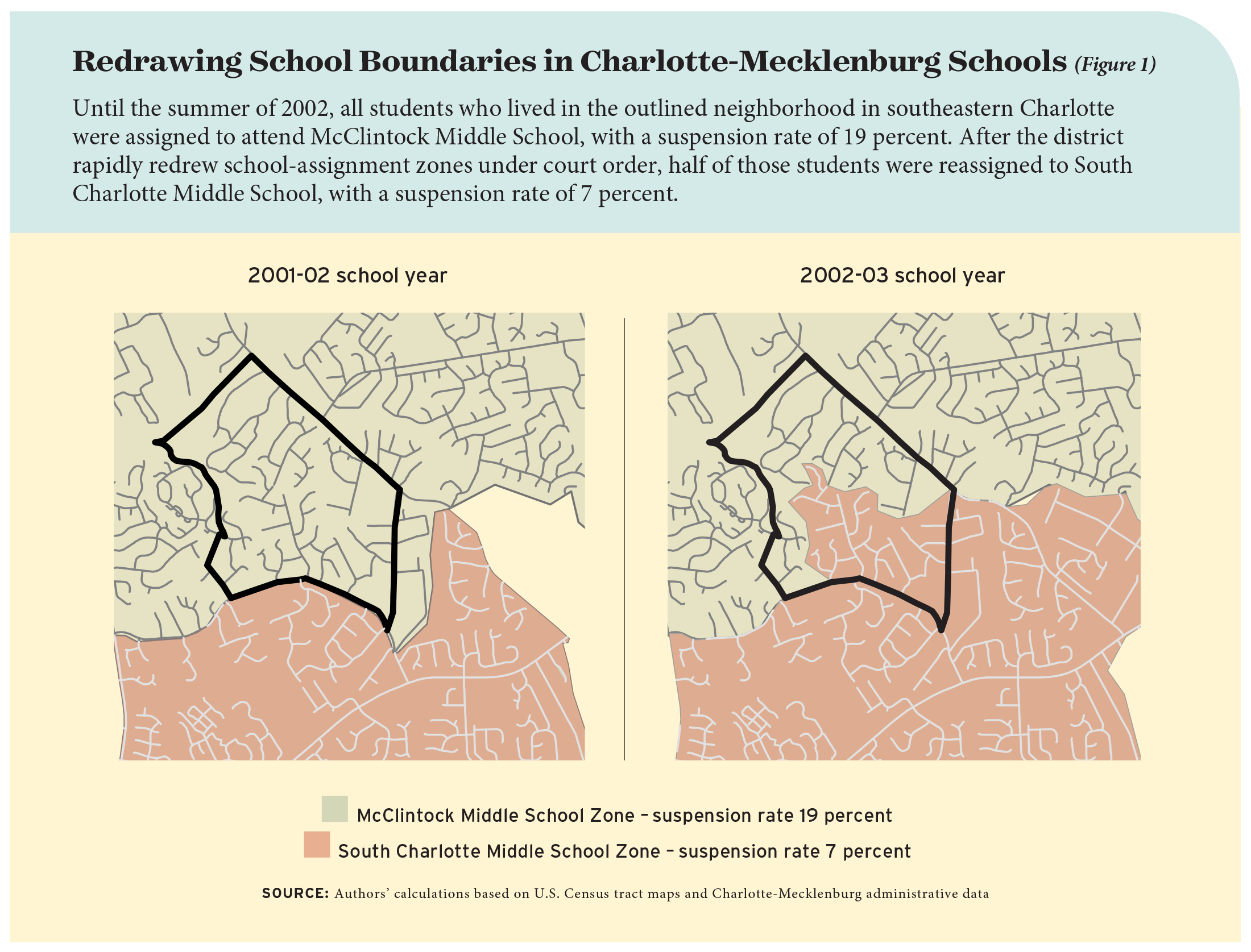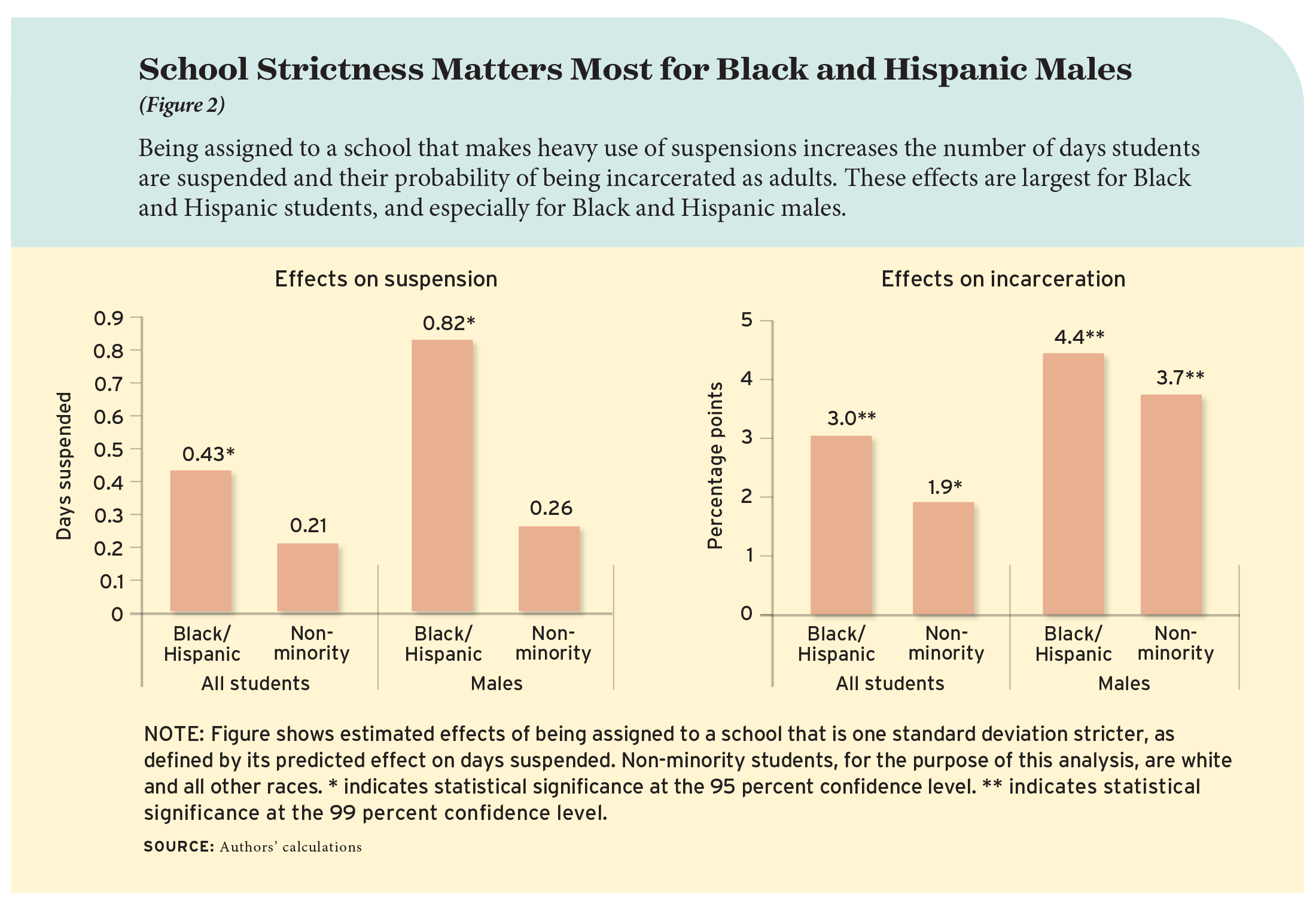
This spring, the Biden administration announced it would seek public comment on student race and school climate, which was roundly viewed as a precursor to restoring an Obama-era directive to reduce racial disparities in discipline practices. Those guidelines, which were rescinded by former Secretary Betsy DeVos, have been variously described as a critical means of protecting students’ civil rights and a dangerous overreach by the federal government that prevented schools from keeping students safe.
At issue is the school-to-prison pipeline—a term often used to describe the connection between exclusionary punishments like suspensions and expulsions and involvement in the criminal justice system. Black and Hispanic students are far more likely than white students to be suspended or expelled, and Black and Hispanic Americans are disproportionately represented in the nation’s prisons.
Is there a causal link between experiencing strict school discipline as a student and being arrested or incarcerated as an adult? Research shows that completing more years of school reduces subsequent criminal activity, as does enrolling in a higher-quality school and graduating from high school. Yet there is little evidence on the mechanisms by which a school can have a long-run influence on criminal activity.
To address this, we examine middle-school suspension rates in Charlotte-Mecklenburg Schools, where a large and sudden change in school-enrollment boundary lines resulted in half of all students changing schools in a single year. We estimate a school’s disciplinary strictness based on its suspension rates before the change and use this natural experiment to identify how attending a stricter school influences criminal activity in adulthood.
Our analysis shows that young adolescents who attend schools with high suspension rates are substantially more likely to be arrested and jailed as adults. These long-term, negative impacts in adulthood apply across a school’s population, not just to students who are suspended during their school years.
Students assigned to middle schools that are one standard deviation stricter—equivalent to being at the 84th percentile of strictness versus the mean—are 3.2 percentage points more likely to have ever been arrested and 2.5 percentage points more likely to have ever been incarcerated as adults. They also are 1.7 percentage points more likely to drop out of high school and 2.4 percentage points less likely to attend a 4-year college. These impacts are much larger for Black and Hispanic male students.
We also find that principals, who have considerable discretion in meting out school discipline, are the major driver of differences in the number of suspensions from one school to the next. In tracking the movements of principals across schools, we see that principals’ effects on suspensions in one school predicts their effects on suspensions at another.
Our findings show that early censure of school misbehavior causes increases in adult crime—that there is, in fact, a school-to-prison pipeline. Further, we find that the negative impacts from strict disciplinary environments are largest for minorities and males, suggesting that suspension policies expand preexisting gaps in educational attainment and incarceration. We do see some limited evidence of positive effects on the academic achievement of white male students, which highlights the potential to increase the achievement of some subgroups by removing disruptive peers. However, any effort to maintain safe and orderly school climates must take into account the clear and negative consequences of exclusionary discipline practices for young students, and especially young students of color, which last well into adulthood.
Desegregation in Charlotte-Mecklenburg
For decades, school enrollment and bus routes in the Charlotte-Mecklenburg school district were designed to achieve racial integration. The busing plan was ordered by a state judge and upheld by a unanimous U.S. Supreme Court decision in 1971, after the Swann family, who were Black, sued to reassign their 6-year-old son from an all-Black school to an integrated school closer to their home. The landmark Swann v. Charlotte-Mecklenburg Board of Education decision required the district to reassign students to new schools to balance their racial composition and influenced similar busing programs nationwide.
It was another parent lawsuit that ultimately ended mandatory busing and redrew school-zone boundaries in Charlotte-Mecklenburg again. In 1997, a white parent named William Capacchione sued the district because he believed his child was denied entrance to a magnet program based on race. This case led to a series of court battles that ended with a 2001 ruling by the Fourth Circuit Court of Appeals, which upheld an earlier state court order to stop using race in school assignments. The district had “eliminated, to the extent practicable, the vestiges of past discrimination in the traditional areas of school operations,” the court ruled.
As a result, over the summer of 2002, Charlotte-Mecklenburg Schools redrew school-attendance boundaries based only on classroom capacity and the geographical concentration of students around a building. This mechanical redistricting process rarely took advantage of environmental features such as streams and major roads, and was controversial because it often bisected existing neighborhoods. About half of all students changed schools between 2001–02 and 2002–03.
For some students, that meant going from a school where suspensions were relatively rare to a school with a different approach to discipline (see Figure 1 for an example). While all schools are held to the district’s code of conduct and guidance by the North Carolina Department of Education, different schools have higher or lower rates of suspensions and expulsions.
Many discussions about the school-to-prison pipeline center on the possibility that students experiencing suspension differ from other students in ways that could explain their higher levels of involvement in the criminal justice system later in life. The sudden reassignment of half of all Charlotte-Mecklenburg Schools students in the summer of 2002 meant that students who live in the same neighborhoods and previously attended the same school could be assigned to attend very different schools in the fall. This creates a natural experiment to identify the impact of a school’s approach to discipline, which we use to identify a school’s influence on a range of outcomes in adulthood, including educational attainment and criminal activity.

A Natural Experiment
Our analysis focuses on 26,246 middle-school students who experienced the boundary change because they were enrolled in a Charlotte-Mecklenburg school in both the 2001–02 and 2002–03 school years. We use district administrative records that track students from 1998–99 through 2010–11. The data include information on student demographics, test scores for grades 3 through 8 in math and reading, and annual counts of days suspended. Overall, 48 percent of students are Black, 39 percent are white, and 8 percent are Hispanic. On average, 23 percent of students are suspended at least once per school year, and the average suspension duration is 2.3 days.
District records also include each student’s home address in every year, which we use to determine individual school assignments under the busing and post-busing regimes. To define residential neighborhood, we use the 371 block groups from the 2000 Census that include at least one Charlotte-Mecklenburg student. We use address records to assign students to these neighborhoods and to middle-school zones for both the pre- and post-2002 boundaries.
To look at long-term outcomes, we first match district records to Mecklenburg County administrative data for all adult arrests and incarcerations from 1998 through 2013. Sixth graders in 2002–03 who progress through school as expected would enter 12th grade in the 2008–09 school year. Because our data on crime extends through 2013, we use two main measures of criminal activity: whether the individual was arrested between the ages of 16 and 21 and whether the individual was incarcerated between the ages of 16 and 21. This allows us to observe crime outcomes for all students who were in grades 6 through 8 in 2002–03.
We also track college-going data from the National Student Clearinghouse. That includes records for every student of college age who had ever attended a Charlotte-Mecklenburg school, including students who transfer to other districts or private schools or who drop out of school altogether. Because our data end in the summer of 2009, we cannot examine longer-run measures of educational attainment such as degree completion. Thus we focus on 7th- and 8th-grade students and measure whether they attended college within 12 months of the fall after their expected high-school graduation date.
Approximately 12 percent of our sample eventually drops out of high school, while 23 percent attend a 4-year college within 12 months of their expected graduation date. Between the ages of 16 and 21 years old, 19 percent are arrested at least once and 13 percent are incarcerated at least once. While well above the national averages in terms of suspensions and crime, Charlotte-Mecklenburg Schools is fairly representative of large, urban school districts in the Southern United States.
The Impacts of a Strict School
To quantify each school’s strictness, we use the same basic method commonly used to estimate individual teachers’ value-added to student test scores. We examine the number of days students are suspended both in and out of school to calculate strictness, while controlling for student characteristics such as test scores, race, gender, special-education status, and limited-English proficiency status, among others. This produces an estimate of each school’s predicted impact on suspensions based on how frequently it had suspended students in previous years.
We find that an increase of one standard deviation in school strictness expands the likelihood of being suspended in a given school year by 1.7 percentage points, or 7 percent. The average annual number of days suspended per year grows by 0.38, a 16 percent increase.
How does this affect student outcomes later in life? We look at criminal activity throughout Mecklenburg County and find that students who attend a stricter school are more likely to be arrested and incarcerated between the ages of 16 and 21.
Students assigned a school that is one standard deviation more strict are 17 percent more likely to be arrested and 20 percent more likely to go to jail, based on our estimated increases of about 3.2 percentage points for arrests and 2.5 percentage points for incarcerations. In looking at what types of crimes are involved, we find that school strictness increases later involvement in crimes related to illegal drugs, fraud, arson, and burglary, but not in serious violent crimes like murder, manslaughter, rape, robbery, and aggravated assault.
We also look at the impact on student academic performance and educational attainment and find no evidence that school strictness affects overall achievement. Because we measure the net effect across all students in a school, this may be due to a balancing of two opposing forces: negative effects of lost instructional time for those students who were suspended and positive effects of reduced number of disruptive peers in the classroom for students who were not.
However, we do find evidence that suspensions negatively affect educational attainment. A one standard deviation stricter school increases the likelihood that a student drops out of high school by 1.7 percentage points, or 15 percent, and decreases the likelihood of attending a 4-year college by 2.4 percentage points, or 11 percent.
We then compare effects by race and find outsized impacts for Black and Hispanic students. Being assigned to a school that is one standard deviation more strict increases the average number of days suspended each school year by 0.43 for Black and Hispanic students compared to 0.21 days for non-minority students. That number is even larger for Black and Hispanic males, who are suspended 0.82 more days each year, on average—more than three times the effect for non-minority males.
As adults, Black and Hispanic students assigned to stricter schools are more likely to be arrested and incarcerated than their non-minority classmates. A one standard deviation stricter school increases the likelihood of being arrested by 3.9 percentage points for Black and Hispanic students compared to 2.7 percentage points for non-minority students (see Figure 2). The effect on incarceration in adulthood is 3.1 percentage points for Black and Hispanic students compared to 1.9 percentage points for non-minority students. Negative effects are especially pronounced among Black and Hispanic male students, who are 5.4 percentage points more likely to be arrested and 4.4 percentage points more likely to be incarcerated as adults.
While the average impact of a strict school across all students is negative, we do find small positive impacts on academic achievement for white male students. White male students who are assigned a school that is one standard deviation stricter score about 0.06 standard deviations higher on middle-school math and reading tests. This is consistent with prior studies that show positive short-run academic benefits to some students from removing disruptive peers from the classroom. However, we find no long-run impact on educational attainment for white males, who also experience substantial increases in adult arrests and incarcerations of 4.9 and 3.7 percentage points, respectively.

What Drives School Strictness?
We investigate three potential factors driving differences in school strictness. First, we look at the potential role of school peers. Prior research has found that peers are important contributors to students’ educational experiences, but we find little relationship between school strictness and peer characteristics, suggesting that our results are not driven by changes in peer composition.
Second, we test our main school strictness results alongside two other measures of school effects, based on student-achievement gains and teacher turnover. We find that disciplinary strictness is the only predictor of students’ later involvement in the criminal-justice system. This serves as further evidence that our results are driven by school effects on suspensions rather than other aspects of school quality or simply the disruption caused by sudden changes in enrollment patterns.
Finally, we turn to the role of school leaders, who have considerable discretion in how they handle disciplinary action. Principals have the authority to set parental meetings, after-school interventions, and in-school suspensions. Even the process for short-term out-of-school suspension is almost completely up to school leaders in Charlotte-Mecklenburg; the superintendent’s approval is only required for long-term suspensions of 11 days or more. We look at the movements of principals across schools and find that when a principal who has been strict in prior years switches into a new school, suspensions in the new school increase. This suggests that school effects on suspensions are driven by leadership decisions.
These findings echo the public’s anecdotal understanding of the strong role that principals play in establishing school climate and discipline. Consider Charlotte-Mecklenburg’s recent approach to limiting suspensions among young elementary-school students. Suspending very young students has come under public criticism across the country, with policymakers in New York City, Colorado, and New Jersey weighing moratoriums on the practice. The Charlotte-Mecklenburg school board considered a moratorium but opted to limit principal discretion instead and now requires the superintendent’s approval. In 2017–18, the first year of the new policy, the number of suspensions for K–2 students fell by 90 percent.
Implications
Misbehaving peers can have strong negative impacts on other students in the classroom, and all students need a safe, predictable, and peaceful environment to thrive. But our findings show that the school-to-prison pipeline is real and poses substantial risks for students in strict school environments. On average, students who attend middle schools that rely heavily on suspensions are at greater risk of being arrested and incarcerated as young adults and less likely to graduate from high school and go to college. Further, these effects are most pronounced for Black and Hispanic males, who are dramatically underrepresented among college graduates and overrepresented in the nation’s prison system.
This raises a critical question for policymakers and educators who enforce strict school discipline: for whom are our schools safe? And it establishes an opportunity for principals and organizations that support school leadership to weigh the tradeoffs between strict discipline practices and longer-term outcomes for students. As the nation continues to grapple with questions about racial equity and police reform, the contributing causal role that school-discipline practices play in raising the risk of criminality in adulthood cannot be ignored.
Andrew Bacher-Hicks is assistant professor of education at Boston University. Stephen B. Billings is associate professor at the University of Colorado Boulder. David J. Deming is professor at the Harvard Kennedy School and Harvard Graduate School of Education.
For more, please see “The Top 20 Education Next Articles of 2024.”
This article appeared in the Fall 2021 issue of Education Next. Suggested citation format:
Bacher-Hicks, A., Billings, S., Deming, D. (2021). Proving the School-to-Prison Pipeline: Stricter middle schools raise the risk of adult arrest. Education Next, 21(4), 52-57.


